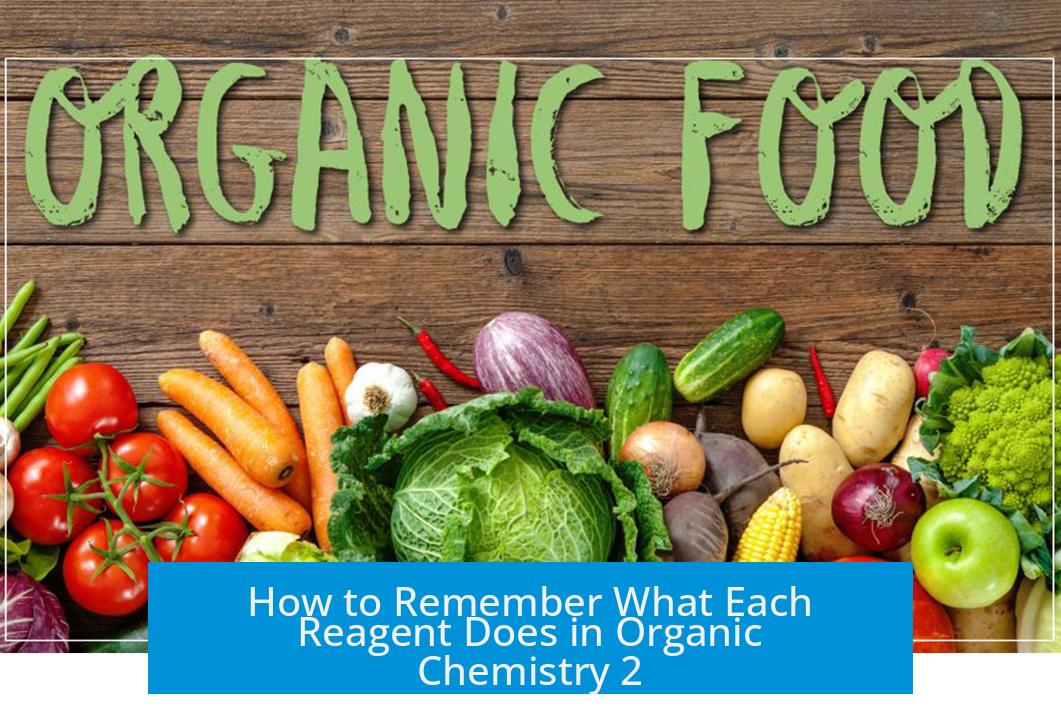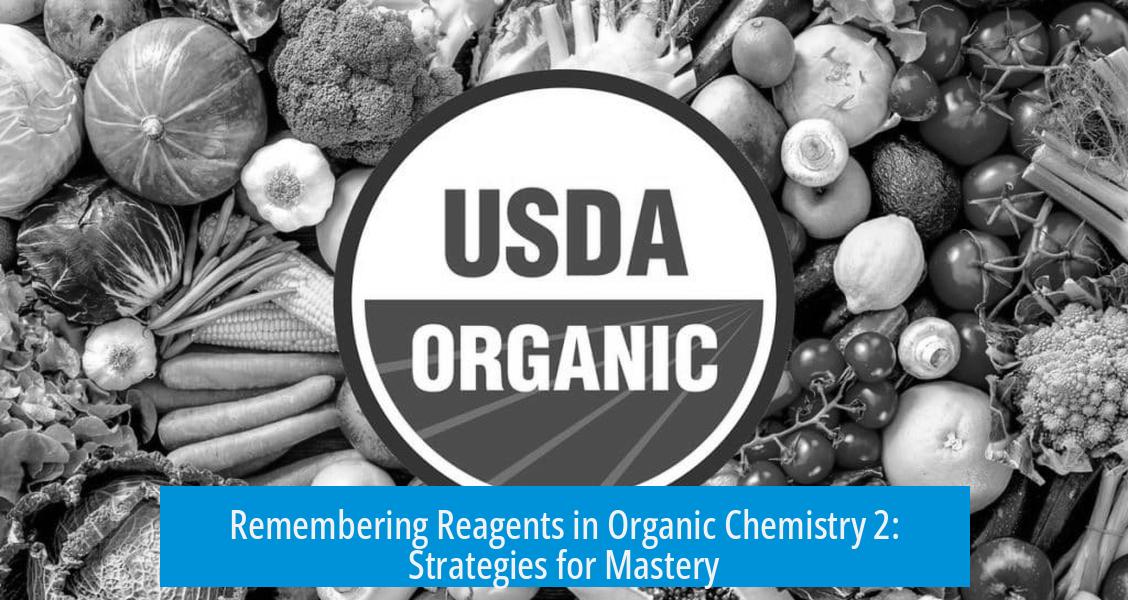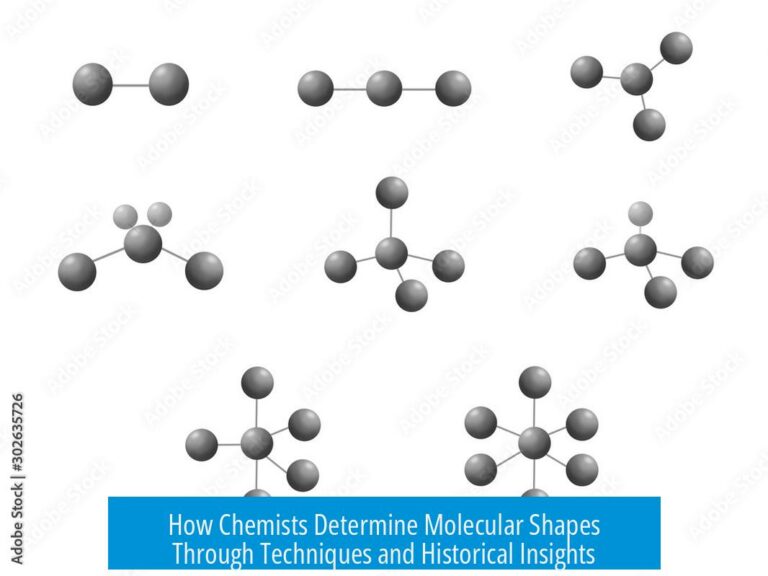How to Remember What Each Reagent Does in Organic Chemistry 2

Remembering what each reagent does in Organic Chemistry 2 hinges not on sheer memorization but on understanding the fundamental principles and mechanisms involved in reactions. This approach allows for predicting reagent behavior in new contexts rather than rote recall. Several strategies help students master reagent functions efficiently and effectively.
1. Learn Rules Instead of Memorizing

Organic chemistry is largely rule-based. Instead of memorizing reagents individually, focus on the general guidelines that govern their behavior. For example, understanding acidity and basicity trends helps predict proton transfers. Learning how nucleophiles and electrophiles interact provides insight into substitution or addition reactions.
Memorize only vital quantitative data such as pKa values for key hydrogens. Even these can often be estimated by applying principles of resonance, inductive effects, and hybridization. Grasping these allows logical predictions about reagent reactivity.

2. Embrace Mechanistic Thinking: Push Plenty of Arrows
Reagents interact with organic molecules via electron movements. Master curved arrow notation to depict electron flow. By practicing mechanisms regularly, a student builds intuition for reagent action.

- Identify nucleophilic and electrophilic sites.
- Visualize electron donation and acceptance in bond-making and breaking.
- Predict intermediate species and reaction pathways.
This mechanistic approach forces deep understanding. Knowing the electron movements involved in reagent transformations eliminates the need to memorize isolated facts about each reagent’s function.
3. Organize Reagents with a Colour-Coded System

Visual organization fosters better memorization and quick recall.
| Category | Colour Code | Examples |
|---|---|---|
| Oxidizing Agents | Red | KMnO4, CrO3 |
| Reducing Agents | Blue | NaBH4, LiAlH4 |
| Acids | Green | H2SO4, HCl (note pKa) |
| Bases | Yellow | OH−, NH2− |
| Nucleophiles | Orange | CN−, Br− |
| Electrophiles | Pink | R+, H+ |
Note any special use reagents (like Tollen’s reagent) separately, using neutral black print for clarity. Keeping a master list with colour coding helps organize knowledge logically and eases the process of recalling reagents during problem solving.

4. Build Secondary, Focused Reagent Lists
Beyond a master list, create specialized subsets focused on reagent types. For instance:
- All oxidizing agents grouped on a coloured sheet.
- Dedicated lists of common reducing agents.
- Separate acid and base reagent groups with pKa annotations.
When faced with a problem requiring a reagent, consult the relevant focused list. Over time, seeing reagents repeatedly in their functional contexts reinforces memory.
5. Practice Repetitive Drawing and Grouping by Reaction Types
Practice accelerates retention. Create cycles of drawing reactions and mechanisms on whiteboards or paper. Rewrite them frequently until intuitive.
Group reagents and reactions by chapters or types:
- Oxidation-reduction reactions
- Nucleophilic substitutions
- Eliminations
- Additions
This contextualization helps identify patterns and connect reagents to reaction classes, improving recall during exams or synthesis planning.
6. Use Reliable Learning Resources
Online and printed resources help categorize reagents systematically. For example, the Florida State University Schwartz site (http://www.chem.fsu.edu/schwartz/) offers organized reagent lists categorized by function and mechanism.
Use such curated content to reinforce understanding and build personalized lists. Structured resources complement active learning and mechanistic approaches.
7. View Reagents as Chemicals Undergoing Change
Understanding reagents as active chemicals rather than abstract tools strengthens deep learning. For example, consider sodium borohydride (NaBH4). It reduces aldehydes and ketones by donating hydride ions (H−). During this, NaBH4 itself is oxidized.
Knowing both how NaBH4 attacks electrophilic carbonyl carbons and that it changes oxidation state helps cement its role in reduction reactions. This mindset applies broadly to other reagents:
- Recognize oxidizing agents as electron acceptors that are themselves reduced.
- View nucleophiles as electron donors getting “used up” in bonds.
- Picture acids and bases exchanging protons in predictable fashions.
This chemical perspective connects concepts rather than fostering rote facts.
Summary: Key Takeaways to Remember Reagent Functions
- Understand principles and rules: Learn organic chemistry fundamentals like acidity, basicity, electrophilicity, and nucleophilicity.
- Master mechanisms: Push curved arrows actively to learn how reagents interact on an electron level.
- Organize with colours: Categorize reagents visually by function for easier recall.
- Create layered lists: Maintain a master list and focused subsets by reaction type.
- Practice frequently: Redraw reactions grouped by chapters to build pattern recognition and intuition.
- Use curated resources: Leverage systematic online reagent databases and summaries.
- See reagents as chemicals: Understand reagent transformations during reactions to strengthen memory.
Adopting these strategies helps students move beyond mere memorization and develop a flexible, mechanistic understanding of reagents in Organic Chemistry 2. This foundation supports success in coursework, exams, and practical applications.
How Do I Remember What Each Reagent Does in Organic Chemistry 2?
If you want to remember what each reagent does in Organic Chemistry 2, STOP trying to memorize every reagent like it’s a shopping list. Instead, focus on learning the rules behind their actions and practice applying those rules through mechanistic arrow-pushing. Build organized, colorful lists and revisit them often by drawing and grouping reagents by reaction type.
Sounds straightforward, right? Yet many students waste their time cramming endless reagent names and functions and then forget it all in an instant. Let me share a better approach—a strategy based on understanding, organization, and repetition that actually sticks.
Forget Rote Memorization: Learn Principles & Predictions Instead
Trying to memorize every reagent’s exact function is like memorizing the phone book to call a friend. It’s exhausting and often pointless. Organic chemistry is a language of mechanisms and principles.
For example, instead of memorizing that a particular reagent is an acid, ask yourself: “What sort of acids do I know? Can I predict how strong this acid is based on pKa rules? Where does it protonate?”
Yes, some critical values like pKa are important, but they often follow patterns you can deduce rather than memorize blindly. Think about acidity trends, resonance, and electronegativity to estimate pKa rather than outright memorization.
Push Arrows Like Your Life Depends On It — Mechanistic Mastery FTW
Here’s a secret weapon: mechanism practice. Practice electron-pushing with curved arrows relentlessly. Understand how reagents interact, where electrons flow, and why.
Don’t treat reagents as black boxes with mysterious “effects.” Rather, think of a reagent as a chemical actor with a role in reactions—for instance, NaBH4 reduces aldehydes because it donates hydride (H-), while itself being oxidized.
When you can draw the mechanism where NaBH4 delivers a hydride and becomes oxidized, you “own” the reagent. You don’t need to memorize “NaBH4 = reducing agent” because you’ve already understood it at a fundamental level. Your brain stores the mechanism, which is way harder to forget than a flashcard.
Make a Mega Colour-Coded Reagents Cheat Sheet — Your Visual Memory Ally
Visual learners rejoice! Grab a large piece of paper and write down every reagent you encounter. Now, grab some vibrant markers or highlighters and colour-code them by their primary function:
- Red – Oxidizing agents
- Blue – Reducing agents
- Green – Acids (plus key pKa values)
- Yellow – Bases (with pKa info too)
- Orange – Nucleophiles (make these distinct from red for clear visibility)
- Pink – Electrophiles
For tricky reagents that don’t fit neatly—that old Tollen’s test or peculiar reagents—note their specialized uses in plain black text. Once you have your “mega list,” create smaller, focused lists for each category (e.g., all oxidants on a blue sheet). This layered approach reinforces memory and speeds retrieval.
Organize by Reaction Chapters & Repeat Drawing to Build Intuition
How do you build deep understanding that lasts? Practice, practice, practice. But not just passive reading. Draw reagents, reactions, and mechanisms repeatedly—as if you’re sketching your way to glory on a whiteboard.
Break your study sessions into chapters or reaction types. One day focus on oxidations; another on nucleophilic substitutions. Group reagents by reaction family so you see the patterns and similarities. Eventually, the mechanisms become intuitive, and you only need to remind yourself of the reagent’s name—not its entire function.
This technique sounds like a slog (no kidding, it is a bit!), but it beats cramming and forgetting. It’s like learning to ride a bike by balancing repeatedly rather than reading a manual.
See Reagents As Chemicals, Not Magic Boxes
Imagine reagents as chemical characters in a story. Sodium borohydride doesn’t just “reduce”—it gets oxidized itself. Understanding their chemical transformations anchors their functions in your mind.
For example, NaBH4 transfers hydride ions; it’s a source of electron density. Tertiary butyllithium (t-BuLi) is a strong base and nucleophile because it has a carbanion-like center. Thinking chemically helps you predict and rationalize their applications instead of blindly stating “this reagent does the following.”
Leverage Online Resources to Organize and Visualize Reagents
Several online resources categorize reagents neatly and can complement your learning. The FSU Schwartz reagents list is a popular tool that organizes reagents by function, mechanism, and reaction type.
Use these as interactive flashcards or visual aids. Don’t rely solely on them; instead, integrate what you see into your own notes and diagrams based on your understanding.
Summary of Practical Tips To Remember Reagents:
- Stop memorizing reagents as isolated facts; learn underlying principles and pKa patterns.
- Push lots of curved arrows; draw mechanisms to make reagent functions tangible.
- Create a color-coded mega-list; see reagents by their roles visually.
- Make smaller, focused lists; retrieve oxidants, bases, or nucleophiles quickly.
- Draw, erase, redraw; group reagents by reaction chapters for pattern recognition.
- Reframe reagents as chemicals undergoing transformation; understand their mechanistic roles.
- Use reputable online tools; complement your learning with categorized reagent databases.
- Be patient; sustained, active study beats last-minute cramming every time.
But, here’s a question to chew on:
Are you ready to transform from a rote-memorizer to a true organic chemist who understands the why behind every reaction?
Remember, chemistry is a language. You don’t learn a language by memorizing every word; you learn how to build sentences and express ideas. Similarly, learn the language of mechanisms and principles. The reagents will then “speak” to you.
So, next time you face a tangled mess of reagents in Organic Chemistry 2, don’t panic. Get your colored pens, draw those arrows, organize the chemicals, and tackle each reagent like it’s a piece of a fascinating puzzle. You’re building a toolbox—not a trivia list. And that’s how you remember what each reagent does, not just now, but forever.
How can I avoid rote memorization and still remember what each reagent does?
Focus on learning the general rules and principles behind reagents. Understand how they behave in reactions rather than just memorizing names. Memorize key data like pKa values only when necessary.
Why is the mechanistic approach recommended for learning reagents?
Pushing curved arrows helps you see how electrons move during reactions. This understanding reveals the reagent’s function naturally. Learning mechanisms beats memorizing isolated facts.
How does color-coding reagents help with memory?
Color coding organizes reagents by type—oxidants red, reductants blue, acids green, and so on. This visual cue separates functions and makes finding and recalling reagents easier.
What is the benefit of creating focused reagent lists?
Breaking the main list into groups like oxidants or nucleophiles speeds up review. It helps you select relevant reagents quickly and reinforces their roles through repetition.
How can repeated drawing and grouping reagents by chapters improve recall?
Writing reagents down multiple times and grouping them by reaction type builds pattern recognition. This practice helps you intuitively understand mechanisms and reagent use.





Leave a Comment